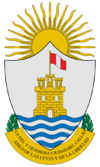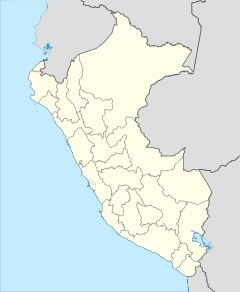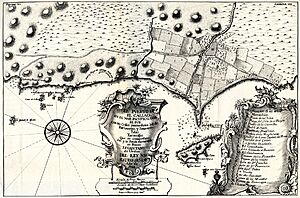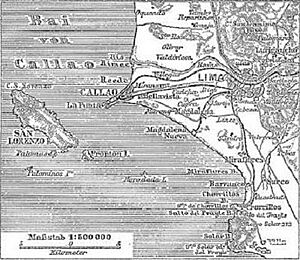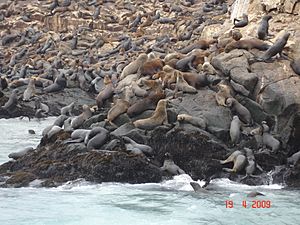Callao facts for kids
Quick facts for kids
Constitutional Province of Callao
Provincia Constitucional del Callao (Spanish)
|
|||
|---|---|---|---|
|
City
|
|||
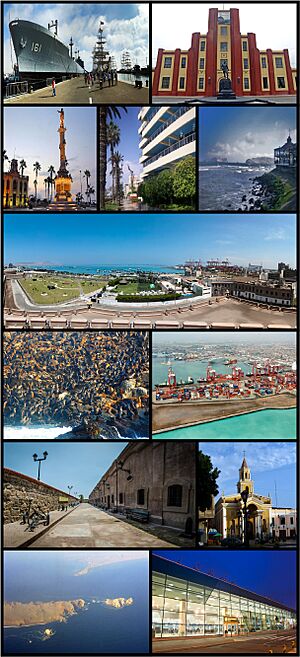
Clockwise from top left: Navy Ship; Leoncio Prado Military College; Miguel Grau Square; La Punta Viewpoint; Real Felipe Fortress; Sea lions; Port Terminal; San José Church; San Lorenzo Island; and Jorge Chávez International Airport
|
|||
|
|||
| Nicknames:
La Perla del Pacífico (Pearl of the Pacific)
El Primer Puerto (The First Harbor) |
|||
| Motto(s):
La fiel y generosa ciudad del Callao, asilo de las leyes y de la libertad. (The faithful and generous city of Callao, asylum of the laws and freedom.)
|
|||
| Country | |||
| Region | Callao | ||
| Provinces | Constitutional Province of Callao | ||
| Founded | 6 March 1537 | ||
| Founded by | Diego Ruiz | ||
| Districts |
7 Districts
Bellavista
Callao (downtown) Carmen de la Legua Reynoso La Perla La Punta Ventanilla Mi Perú |
||
| Area | |||
| • Total | 147.85 km2 (57.09 sq mi) | ||
| Elevation | 5 m (16 ft) | ||
| Population
(2017)
|
|||
| • Total | 1,300,000 | ||
| • Density | 8,800/km2 (22,800/sq mi) | ||
| Demonym(s) | Chalaco/a | ||
| Time zone | UTC-5 (PET) | ||
| Postal code |
07001
|
||
| Area code(s) | 14 | ||
| Website | Official Website: http://www.municallao.gob.pe | ||
Callao (pronounced ka-YOW) is a busy port city in Peru, right on the Pacific Ocean. It's part of the larger Lima metropolitan area. Callao is Peru's most important seaport and home to its biggest airport, Jorge Chávez International Airport. The city of Callao is also its own special region, called the Constitutional Province of Callao. It was founded by the Spanish in 1537. Callao has a long history as a major port in Latin America and the Pacific. It was a very important Spanish town during the time Peru was a colony. Central Callao is about 15 kilometers (9 miles) west of Lima's historic center.
Contents
History of Callao
Callao was founded by Spanish settlers in 1537, just two years after Lima. No one is completely sure where the name "Callao" came from. It might be from an old local language or even a Portuguese word meaning "pebble."
It quickly became the most important port for Spanish trade in the Pacific Ocean. During the time Peru was a Spanish colony, many goods from Peru, Bolivia, and Argentina traveled by mule over the Andes mountains to Callao. From there, they were shipped across the Pacific to Panama, then overland, and finally to Spain.
Callao was also a stop on the famous Manila galleon route. This route connected Latin America and Asia, going through Acapulco, Mexico, and Manila, Philippines. Because it was so important, Callao was often attacked by pirates like Francis Drake in 1579.
After the Battle of Ayacucho in 1824, Peru became independent from Spain. On August 20, 1836, Callao became the Callao Littoral Province. This meant it had its own government. Later, on April 22, 1857, it was given the special name of Constitutional Province. This was unique because most other provinces in Peru got their names by law, but Callao's name was given by a special constitutional rule.
Callao has never been part of the Lima Department or any other Peruvian region. The first mayor of the province was Colonel Manuel Cipriano Dulanto.
In 1921, a new road was built between Callao and Lima. This helped the two cities grow closer and form the Lima metropolitan area.
Important Moments in Callao's History
- In 1746, a huge tsunami (a giant ocean wave) caused by an earthquake destroyed the entire port of Callao.
- In 1826, after a long fight, Spanish forces in Callao surrendered to the independent Peruvian army. This was an important step for Peru's freedom.
- In 1866, during the Battle of Callao, the Spanish navy tried to take back independent Peru, but they were defeated.
- The famous Kon-Tiki raft, used by explorer Thor Heyerdahl, started its journey from Callao in 1947.
What to See in Callao
Callao is built around a peninsula called La Punta. This is a nice residential area. A historic fort, the Real Felipe Fortress, stands on a hill overlooking the harbor. It's a great place to learn about history.
Callao is home to a large naval base. The Jorge Chávez International Airport, Peru's main airport, is also located here.
You can find the Colegio Militar Leoncio Prado, a military high school, on a bluff above the harbor. Callao also has its own university, the National University of Callao.
People who live in Callao are called chalacos. This name comes from the Quechua word Chala, which means "coast."
Callao has two professional football (soccer) teams: Sport Boys and Atlético Chalaco.
Islands Near Callao
Callao has several islands nearby. San Lorenzo Island is currently a military base. El Frontón used to be a high-security prison. The Cavinzas Islands and the Palomino Islands are home to many sea lions and sea birds. These islands are important for their untouched natural environment. There are plans to build a very large port on San Lorenzo Island in the future.
Getting Around Callao
Airport
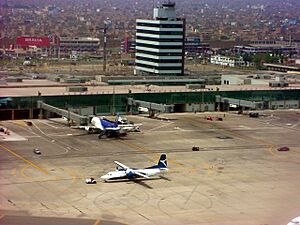
Jorge Chávez International Airport (LIM) is Peru's main airport for both international and local flights. It is located in the Callao District, about 12 kilometers (7.5 miles) northwest of Lima's historic center. Callao is a port city that is now fully connected with Lima, the capital of Peru. In 2008, over 8 million passengers used this airport.
The airport is a hub for many airlines like Avianca Perú, Viva Air Perú, and LATAM Perú.
Railway
The port of Callao is connected by the Ferrocarril Central Andino railway. This railway helps transport goods to and from the port.
Famous People from Callao
Many talented people come from Callao!
- Alexander Callens (born 1992), a Peruvian football player.
- Luciana Fuster (born 1999), a Peruvian model and TV personality who won Miss Grand International 2023.
- Claudio Pizarro (born 1978), a football player who scored more goals than any other Latin American in the German Bundesliga league.
- Yma Sumac (born 1922), a famous Peruvian musician.
- Nolberto Solano (born 1974), considered one of the best football players in Peru's history!
See also
 In Spanish: Callao para niños
In Spanish: Callao para niños



